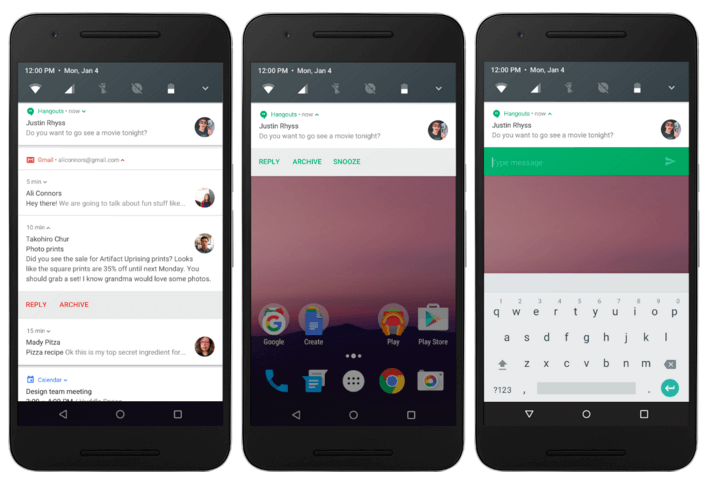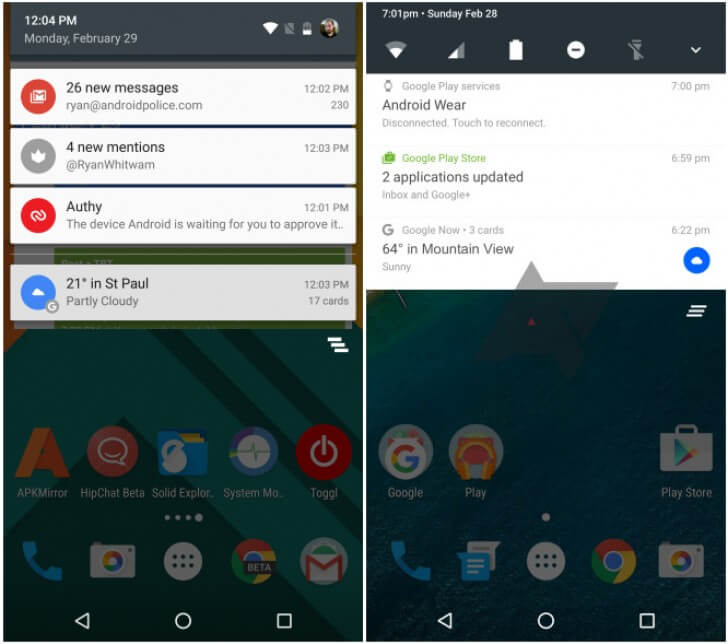Android N Developer Preview 4 has been recently released. According to the Google, Developer Preview 4 includes the final APIs, which is API level 24. That means apps can now be published with support for API level 24 on Google Play in alpha, beta, and production release channels. Google is also providing the final API to Android Studio 2.1.2 and higher, while also pushing system images to the emulator.
New in Developer’s Preview 4
Android N final APIs
Developer Preview 4 includes the final APIs for the upcoming Android N platform. The new API level is 24.
Play publishing
You can now publish apps that use API level 24 to Google Play, in alpha, beta, and production release channels.
Android Studio and tools updates
Along with Developer Preview 4 Google is providing the final API 24 SDK to be used with Android Studio 2.1.2 and higher. In addition, Google is releasing updated Developer Preview 4 system images for the emulator to help test your apps.
As new updates roll out for Android Studio, you should see minor improvements in the new project wizards and AVD manager as we add enhanced support for API 24. These are primarily cosmetic changes and should not stop you from getting your app ready for an update in the Play store.
Here are some of the new feature changes:
- In previous versions of Android, an app activates with all of its locale resources loaded before locale negotiation begins. Starting in Android N DP4, the system negotiates resource locales individually for each resource object before the app activates.
- As announced at Developer Preview 3, Google deferred the Launcher Shortcuts feature to a later release of Android. In Developer Preview 4, Google removed the Launcher Shortcuts APIs.
- Google has changed the BLE Scanning behavior starting in DP4. They have prevented applications from starting and stopping scans more than 5 times in 30 seconds. For long running scans, google will convert them into opportunistic scans.
- The Multi-Window android:minimalHeight and android:minimalWidth attributes have been renamed to android:minHeight and android:minWidth.

Known Issues:
- Stability – Users may encounter system instability (such as kernel panics and crashes).
- Launcher – The default launcher’s All Apps tray may become unresponsive after cycling the screen off and on. Returning to the homescreen and relaunching the All Apps tray may resolve this issue.
- Setup Wizard – Crash on selecting “Not now” in “Set up email” screen.
- Media – Media playback may be unreliable on Nexus 9 and Nexus Player, including issues playing HD video.
-Occasional freeze when running the YouTube app with other apps in multi-window mode on Pixel C devices. In some cases hard reboot is required.
-Apps may have issues playing some Widevine DRM-protected content on Nexus 9 devices.
-Issues handling VP8 video on Nexus 9 devices. - External storage – Apps may become unstable when the user moves them from internal storage to adoptable external storage (this can include SD card or devices attached over USB).
- Screen zoom and multiple APKs in Google Play – On devices running Android N, Google Play services 9.0.83 incorrectly reports the current screen density rather than the stable screen density. When screen zoom is enabled on these devices, this can cause Google Play to select a version of a multi-APK app that’s designed for smaller screens. This issue is fixed in the next version of Google Play services and will be included in a later Developer Preview release.
- Vulkan support and multiple APKs in Google Play – On devices running Android N, Google Play services 9.0.83 currently reports Vulkan support but not Vulkan version. This can cause Google Play to select a version of a multi-APK app that’s designed for lower Vulkan support on devices with higher version support. Currently, the Google Play Store does not accept uploads of apps which use Vulkan version targeting. This support will be added to the Google Play Store in the future and fixed in the next version of Google Play services (to be included in a later Developer Preview release). Any N devices using the version of Google Play services 9.0.83 will continue to receive versions of apps targeting basic Vulkan support.
- Accessibility – Switch access doesn’t allow user to navigate web pages in Chrome.
-Accessibility issues for talkback users with notification dismissal, and wifi selection screen. - Android for Work – Currently, CA certificates provisioned through DevicePolicyManager are not available to profiles other than the primary user/profile due to a preload issue. For example, this could prevent a user from connecting to a trusted server when in a Work profile. This issue will be resolved in the next Developer Preview.
If you’re a developer and would like to make sure your updated application runs well on Android N, you’ll want to look into using Google Play’s beta testing feature.
Coming in a build number NPD56N, factory images are now available for the Nexus 6P, Nexus 5X, Nexus 6, Nexus 9, Pixel C, Nexus Player, General Mobile 4G (Android One) and the Sony Xperia Z3. Full OTA images are also available, but not for the Z3. If you aren’t keen on updating manually, you can always enroll your device in the Android Beta Program.
For a complete overview of what’s new for users and developers, Approach Mantra Labs at hello@mantralabsglobal.com
Knowledge thats worth delivered in your inbox










